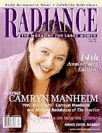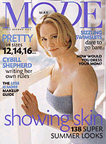Do clothes make the woman? These days, the catwalk has become a podium for size acceptance. But will big, beautiful women find real power there? BY OPHIRA EDUT
 I’M CHILLING ON THE COUCH WITH A BAG OF CHEETOS, watching a beauty pageant on the tube. Women parade across the stage, draped in gowns, after-five wear, casual attire. A mustached emcee introduces contestants, pauses to belt out a patriotic hymn. The judges smile tightly. It’s your standard glamfest.
I’M CHILLING ON THE COUCH WITH A BAG OF CHEETOS, watching a beauty pageant on the tube. Women parade across the stage, draped in gowns, after-five wear, casual attire. A mustached emcee introduces contestants, pauses to belt out a patriotic hymn. The judges smile tightly. It’s your standard glamfest.
Only…it’s not. See, the contestants tonight aren’t the binge-and-purge Barbies of pageantry past. The average contender sports a size 20 dress. The smallest woman in the running is no less than a 14-16. And the emcee intersperses his show tunes with some eye-opening stats: Forty percent of women wear a size 14 or above…Sales of plus-size clothes in 1996 were more than $20 billion…In 1990, there were only 200 vendors in the plus-size market; now there are 2,000. Hold on a minute–what is this?
It’s the thirteenth annual Plus USA Woman beauty pageant and convention, that’s what. And I’m watching it on videotape, because network America ain’t ready to televise full-figured women feeling good about their bodies. When a young woman named Michele Drumm, who is indeed stunning, tearfully accepts the crown, I cheer. “About time us thick chicks got our proper respect!” I declare through a mouthful of Cheetos.
Yet, the whole scene leaves me a little confused. I’ve spent half a decade recovering from warped body image, foisted on my ample-bootied consciousness by couturiers and media alike. I’ve depleted the ozone layer talking endlessly about an epiphany I had in the Contempo Casuals dressing room, circa ’92: There’s nothing wrong with me or my body because I can’t fit into these clothes–it’s the people who design for unrealistic bodies who have the problem.
And now, those same people want to sell me back my revolution at a 20 percent retail markup. It’s eerie, I tell you. Liz Claiborne has a plus line called Elisabeth, Anne Klein now offers Anne Klein II, and even Bloomingdales is touting an expanded twelve-and-up department. Lane Bryant, once on the “mall of shame” circuit, is now a modicum of coolness, replete with runway shows and funky ads. Instead of buying Vogue, I could read Mode, a slick fashion magazine for women sizes 12, 14 and 16. (Mode’s 1997 launch was so successful that its frequency jumped from quarterly to monthly a year ahead of schedule. It’s now out of print, but it made a lasting impression.)
 Still, I can’t help but wonder: Are we catching whiff of a revolution or a scam? Are fashion designers trying to build up my self-esteem and change the culture, or to make a quick buck? It may be too soon to tell. My inner skeptic says, “C’mon, if the fashion models got any thinner than Kate Moss, they were gonna fall through the cracks in the runway! The only way to go was up.” The idealist says, “Right on! The designers finally heard what women have been saying since Twiggy — that beauty comes in all sizes, that full-figured women deserve the same rights as everyone else.”
Still, I can’t help but wonder: Are we catching whiff of a revolution or a scam? Are fashion designers trying to build up my self-esteem and change the culture, or to make a quick buck? It may be too soon to tell. My inner skeptic says, “C’mon, if the fashion models got any thinner than Kate Moss, they were gonna fall through the cracks in the runway! The only way to go was up.” The idealist says, “Right on! The designers finally heard what women have been saying since Twiggy — that beauty comes in all sizes, that full-figured women deserve the same rights as everyone else.”
But will we get them? Will equal access to haute couture lead to equal rights in the workplace, in health care and everywhere else size discrimination runs rampant?
Alice Ansfield, who published Radiance: The Magazine for Large Women” from 1984 until the late 1990s, says her feelings are also mixed.
“We all need to be clothed and we all want to have the options — including haute couture–that everyone else has,” says Ansfield. “More plus-size women [in the mainstream] means more women are accepting their bodies to a certain degree, and aren’t totally devastated by gaining five, ten or 20 pounds. I see fat women wearing swimsuits to the beach and pool, or wearing shorts, and not walking with their heads hanging down. But the deep cultural prejudice remains…It’s a push-pull; gain a few inches, go back a few feet.”
 Fashion is hardly new material at Radiance, anyway. Since day one, the magazine promoted independent plus- and supersize designers and encouraged fat women to revel in their abundant flesh.
Fashion is hardly new material at Radiance, anyway. Since day one, the magazine promoted independent plus- and supersize designers and encouraged fat women to revel in their abundant flesh.
But Radiance is sort of like Mode turned inside out; it focuses on content more than image. The meat of Radiance confronts size discrimination head-on. It’s an empowering read–but, of course, Radiance is struggling to stay alive.
Mode, on the other hand, appeared to be on the road to profit from the get-go. Its design was more upscale than Radiance, and its publishers clearly had connections in the mainstream media (the founders formerly worked at Glamour.) Fashion was the heart and soul of Mode’s mission. The beautiful outfits (I could actually wear them!) made me drool, but the bland and unchallenging articles left me wanting.
 At first I was like, damn, doesn’t it figure? Women really value style over substance. A nice-looking magazine flies off the racks, but a well-written one sits on the shelf. What do we want here–a new society or a new wardrobe?
At first I was like, damn, doesn’t it figure? Women really value style over substance. A nice-looking magazine flies off the racks, but a well-written one sits on the shelf. What do we want here–a new society or a new wardrobe?
But then I remember a few of my friends from high school. Big girls who entered the Gap or Express looking for cute outfits, only to be smacked with the absence of anything in their size. They internalized the shame of this exclusion, hid in shapeless tunics and baggy sweaters. Their posture and presentation drooped like the unflattering clothes, designed with the ridiculous goal of making big women inconspicuous.
 Maybe fashion is the tip of a much larger iceberg. Plus-size fashion might be a Band-Aid; it might be guerrilla activism. After all, how can women stop cringing at our own curves and rolls unless we see them presented as “normal” in the media?
Maybe fashion is the tip of a much larger iceberg. Plus-size fashion might be a Band-Aid; it might be guerrilla activism. After all, how can women stop cringing at our own curves and rolls unless we see them presented as “normal” in the media?
Either way, body image is a huge predicament for women. A visible plus-size fashion scene could make an important dent. If clothes and plus size swimwear can inspire women of all sizes to project confidence and demand to be treated with dignity, this could spiral into a much bigger coup.
Part of my own liberation was the discovery that I was not defined by my appearance.
That my truest beauty lay in my soul, my personality, my talents. For a while, I rejected fashion altogether; dressed in sweats and baggy things until I proved to myself that I could catch people’s attention without the outside trappings. When I felt good and sure of that, something interesting happened. I returned to fashion with an awakened consciousness. Fashion and image became tools for my self-expression. My stringent rules relaxed, and my closet took on multiple personalities, with everything from sweatshirts to suits to sundresses. Now I listen to myself and wear whatever the hell I want. I like to augment my presence in a world that sometimes wants me to stay silent. And I enjoy treating the world to a little shock therapy when my pants snugly silhouette my round stomach and thick thighs–areas that Cosmo would surely advise I keep covered. There’s a bit of activism in that.
DeLores Pressley, founder of the Plus USA Woman pageants, would agree. Pressley, 42, held the first pageant in 1984, with a mission of proving that women of any size can enjoy health, style and self-esteem. Billing herself as a “perfect size 20,” Pressley began her own modeling career in 1983.
“I went to maybe ten agencies and they all turned me down,” she recalls. “Said I had a nice look, but was much too big.” Pressley was finally accepted into a small modeling school in her Canton, Ohio hometown; soon after, she won a national Full Figure Model Award. The victory led her to start Dimensions Plus, an Ohio-based modeling agency for plus-size women.
Today, Dimensions Plus manages 60 models, landing print campaigns and accounts with major national corporations. “Our pageant is much more than a pageant,” says Pressley.”It’s sort of like a coming out. We have seminars on health and fitness. We’re not advocates of obesity; we still want people to be healthy. But we also want to say, ‘No matter how much you weigh, you can still look stunning with the right wardrobe, the right accessories.'”
Okay, but what about the women who can’t afford those? After all, size discrimination has economic ramifications, too. Many people living below the poverty level are fat. This is partly based on employers’ prejudice–fat people are stereotyped as lazy and lower-class, and are less likely to be hired in many instances. The National Association to Advance Fat Acceptance (NAAFA) has documented stacks of legal cases where employees were harassed, fired and forced to resign on the basis of body size.
NAAFA’s policy states: “Fat people are not hired as often as those of average size, are not promoted as often, are paid less than their thinner counterparts, may be charged more for employee insurance coverage, and are sometimes fired because of their weight. Higher insurance costs, increased health risk, client or customer size biases, job performance, grooming, and employers’ aesthetic preferences are reasons cited for firing or for refusing to hire or promote qualified fat workers.” Hmmm….coincidence?
And let’s not forget that “plus-size,” in retail terms, means sizes 12, 14 and 16. Since the majority of U.S. women are plus-size, are we really just repackaging “average” women into a new consumer order? We’re marketing products to the masses — a sound business decision, but hardly a subversive political act.
Even if this trend widens the circle of “acceptable” weight, the many women who don’t fill the bill are still left on the margins. What about women whose dress sizes shoot way above the 12-14-16 range?
“Designers and manufacturers are opening up their lines,” says Ansfield. “But what most of them consider plus-size stops at size 24, so they’re missing more than one-third of the plus-size arena. People don’t stop at size 24.”
And the price may still be wrong—literally—for plus-size women. “A lot of our clothes already cost more,” Ansfield points out. “Manufacturers say they charge more because they’re using more material. So, we tend to pay more of a premium for the clothes we’re already buying, at whatever level. An average-weight woman can go into a discount store and get pretty inexpensive clothes. But even there, the clothes for large women are more expensive.”
Let’s look at the worst case scenario: If the new fashion trends don’t lead to a more size-friendly society, then we might just end up played for even bigger (albeit better-dressed) suckers.
Fashion should be a short-term solution. It should parlay women of size into visibility, forcing the public to accept what we’ve always known—that powerful, capable, beautiful women come in every shape imaginable.
When that’s accomplished, I say let’s burn the evidence. Ultimately, our goal should be to topple the idea that women’s power is rooted in beauty. How can we do that if we continue encouraging women to overemphasize appearance? Dressing up can be an expensive, time-consuming, energy-sucking process. If we don’t keep this trend in check, the plus-size industry could end up creating a new hierarchy, one based not on size, but on a woman’s ability to buy the “right” image.
Clearly, the market for plus-size fashion is growing. Can we seize control of its course and use it to our advantage? Maybe. After all, look how the Spice Girls sparked a dormant dialogue about feminism and empowerment. Sometimes the silliest things springboard us into change. So let’s make sure that when we hang up those size 22 jackets in our closets, we clear out the skeletons, too.
After all, what’s the use of getting all dressed up, unless we have somewhere to go?
Related Content:
New York Fashion Week To Include Curves
The Sad Truth About Shopping for Plus Sizes